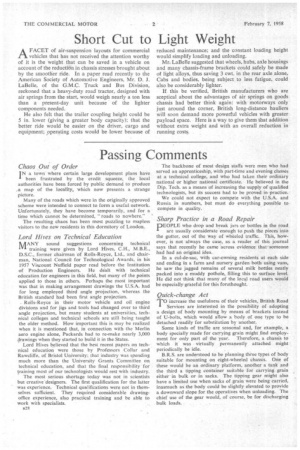Short Cut to Light Weight
Page 38

If you've noticed an error in this article please click here to report it so we can fix it.
A FACET of air-suspension layouts for commercial vehicles that has not received the attention worthy of it is the weight that can be saved in a vehicle on account of the reduction in chassis stresses brought about by the smoother ride. In a paper read recently to the American Society of Automotive Engineers. Mr. D. J. LaBelle, of the G.M.C. Truck and Bus Division, reckoned that a heavy-duty road tractor, designed with air springs from the start, would weigh nearly a ton less than a present-day unit because of the lighter components needed.
He also felt that the trailer coupling height could be 5 in. lower (giving a greater body capacity); that the better ride would be easier on the driver, cargo and equipment; operating costs would be lower because of reduced maintenance; and the constant loading height would simplify loading and unloading.
Mr. LaBelle suggested that wheels, hubs, axle housings and many chassis-frame brackets could safely be made of light alloys, thus saving 3 cwt. in the rear axle alone. Cabs and bodies, being subject to less fatigue, could also be considerably lighter.
If this be verified, British manufacturers who are sceptical about the advantages of air springs on goods chassis had better think again: with motorways only just around the corner, British long-distance hauliers will soon demand more powerful vehicles with greater payload space. Here is a way to give them that addition without extra weight and with an overall reduction in running costs.
































































































































